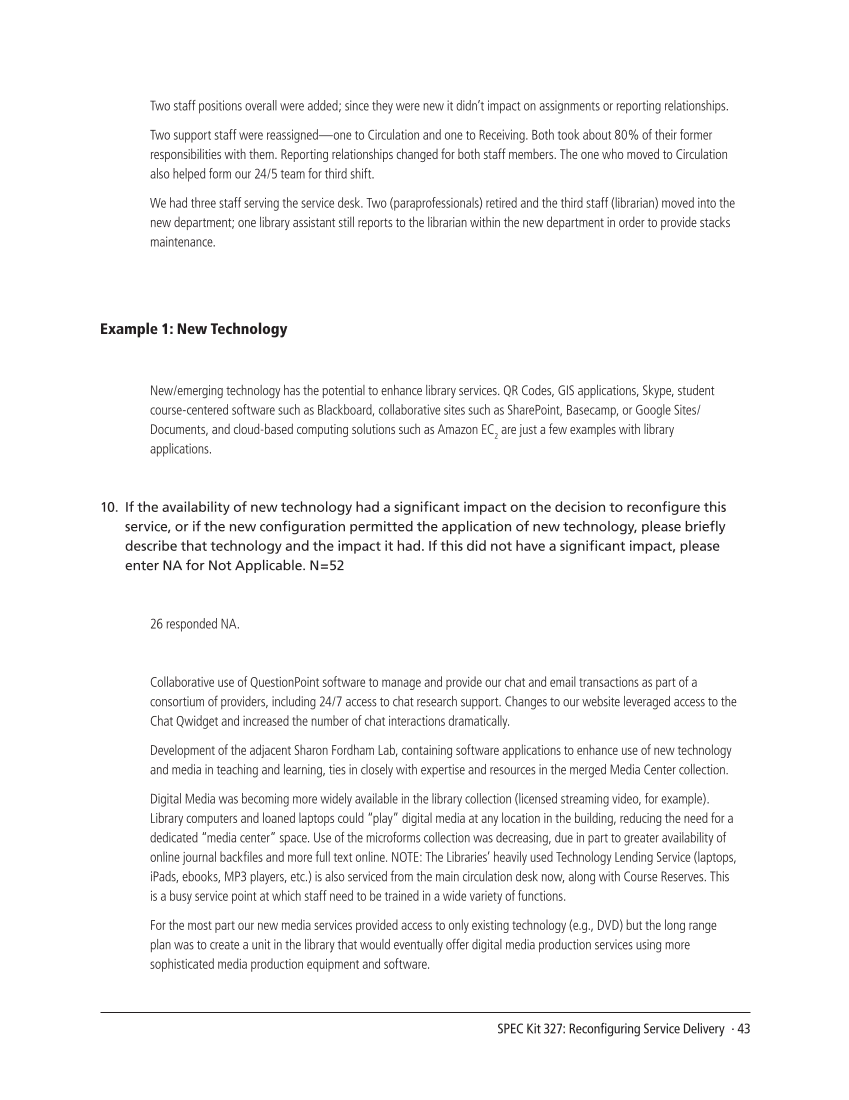SPEC Kit 327: Reconfiguring Service Delivery · 43
Two staff positions overall were added since they were new it didn’t impact on assignments or reporting relationships.
Two support staff were reassigned—one to Circulation and one to Receiving. Both took about 80% of their former
responsibilities with them. Reporting relationships changed for both staff members. The one who moved to Circulation
also helped form our 24/5 team for third shift.
We had three staff serving the service desk. Two (paraprofessionals) retired and the third staff (librarian) moved into the
new department one library assistant still reports to the librarian within the new department in order to provide stacks
maintenance.
Example 1: New Technology
New/emerging technology has the potential to enhance library services. QR Codes, GIS applications, Skype, student
course-centered software such as Blackboard, collaborative sites such as SharePoint, Basecamp, or Google Sites/
Documents, and cloud-based computing solutions such as Amazon EC
2
are just a few examples with library
applications.
10. If the availability of new technology had a significant impact on the decision to reconfigure this
service, or if the new configuration permitted the application of new technology, please briefly
describe that technology and the impact it had. If this did not have a significant impact, please
enter NA for Not Applicable. N=52
26 responded NA.
Collaborative use of QuestionPoint software to manage and provide our chat and email transactions as part of a
consortium of providers, including 24/7 access to chat research support. Changes to our website leveraged access to the
Chat Qwidget and increased the number of chat interactions dramatically.
Development of the adjacent Sharon Fordham Lab, containing software applications to enhance use of new technology
and media in teaching and learning, ties in closely with expertise and resources in the merged Media Center collection.
Digital Media was becoming more widely available in the library collection (licensed streaming video, for example).
Library computers and loaned laptops could “play” digital media at any location in the building, reducing the need for a
dedicated “media center” space. Use of the microforms collection was decreasing, due in part to greater availability of
online journal backfiles and more full text online. NOTE: The Libraries’ heavily used Technology Lending Service (laptops,
iPads, ebooks, MP3 players, etc.) is also serviced from the main circulation desk now, along with Course Reserves. This
is a busy service point at which staff need to be trained in a wide variety of functions.
For the most part our new media services provided access to only existing technology (e.g., DVD) but the long range
plan was to create a unit in the library that would eventually offer digital media production services using more
sophisticated media production equipment and software.
Two staff positions overall were added since they were new it didn’t impact on assignments or reporting relationships.
Two support staff were reassigned—one to Circulation and one to Receiving. Both took about 80% of their former
responsibilities with them. Reporting relationships changed for both staff members. The one who moved to Circulation
also helped form our 24/5 team for third shift.
We had three staff serving the service desk. Two (paraprofessionals) retired and the third staff (librarian) moved into the
new department one library assistant still reports to the librarian within the new department in order to provide stacks
maintenance.
Example 1: New Technology
New/emerging technology has the potential to enhance library services. QR Codes, GIS applications, Skype, student
course-centered software such as Blackboard, collaborative sites such as SharePoint, Basecamp, or Google Sites/
Documents, and cloud-based computing solutions such as Amazon EC
2
are just a few examples with library
applications.
10. If the availability of new technology had a significant impact on the decision to reconfigure this
service, or if the new configuration permitted the application of new technology, please briefly
describe that technology and the impact it had. If this did not have a significant impact, please
enter NA for Not Applicable. N=52
26 responded NA.
Collaborative use of QuestionPoint software to manage and provide our chat and email transactions as part of a
consortium of providers, including 24/7 access to chat research support. Changes to our website leveraged access to the
Chat Qwidget and increased the number of chat interactions dramatically.
Development of the adjacent Sharon Fordham Lab, containing software applications to enhance use of new technology
and media in teaching and learning, ties in closely with expertise and resources in the merged Media Center collection.
Digital Media was becoming more widely available in the library collection (licensed streaming video, for example).
Library computers and loaned laptops could “play” digital media at any location in the building, reducing the need for a
dedicated “media center” space. Use of the microforms collection was decreasing, due in part to greater availability of
online journal backfiles and more full text online. NOTE: The Libraries’ heavily used Technology Lending Service (laptops,
iPads, ebooks, MP3 players, etc.) is also serviced from the main circulation desk now, along with Course Reserves. This
is a busy service point at which staff need to be trained in a wide variety of functions.
For the most part our new media services provided access to only existing technology (e.g., DVD) but the long range
plan was to create a unit in the library that would eventually offer digital media production services using more
sophisticated media production equipment and software.






















































































































































































































